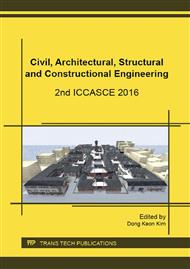p.3
p.10
p.15
p.22
p.29
p.34
p.38
p.44
Design and Analysis of the Health Monitoring System for the Steel Arch of the Main Stadium Roof in Nanjing Olympic Sports Center
Abstract:
For the purpose of grasping the stress state, vibration characteristics and safety of the steel arch in Nanjing Olympic Sports Center, which is the main support among the stadium roof system as well as the world's largest oblique arch structure, a real-time health monitoring system was established and the main achievements including the system constitution, monitoring items and layouts of measuring points were described. The monitoring data measured during the 2 years period from 2014 to 2016 as well as the SAP2000 finite element software were combined to conduct the status identification and safety evaluation. The results show that the simulation results are consistent with the measured date; The measured alignment of the large arch is relatively stable, although the structural stiffness of arch has weakened compared with the designed state, the low order vibration frequencies are stable during the 2 years period; The stress state of each monitoring component is at safe levels, and fluctuates within a small range affected by the extreme seasonal temperature changes.
Info:
Periodical:
Pages:
3-9
Citation:
Online since:
November 2016
Authors:
Price:
Сopyright:
© 2017 Trans Tech Publications Ltd. All Rights Reserved
Share:
Citation:


